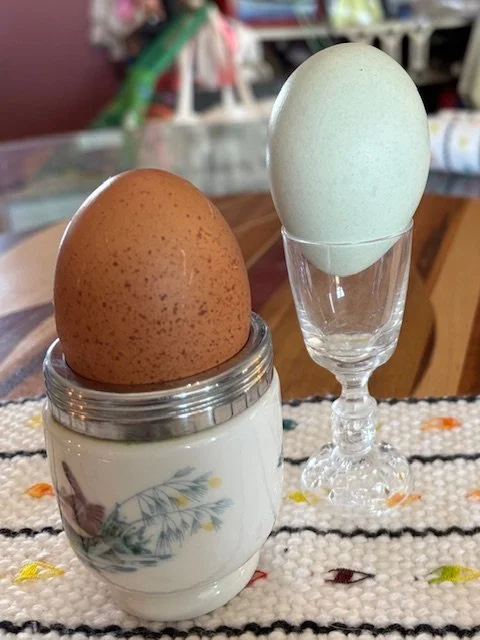Eggucation
Last week I had to give an adult a biology lesson on avian anatomy how eggs are laid. It showed me how far removed most people are about the basics of where their food comes from and how it’s produced. There I was explaining the birds and bees, or should I say hens and chicks, to someone who should have learned this in the fifth grade as I had.
I stuck to chickens as ducks have a different anatomy structure altogether. The patron would probably think I was pulling their leg if I told them how the male duck’s corkscrew-shaped reproductive equipment fell off at the end of mating season each year and then grew back the following year. But hey, this is a family market. Equally disturbing was the question about how many roosters are needed to get hens to lay eggs. Um..most women lay eggs every month with or without a rooster—you know what I mean? The light over the barn door went on at that point and they ended the conversation before I delved deeper into poultry physiology.
How could people be so uninformed over an item that has come to gauge the state of our national economy? This is also the time of year when we can’t get away from the iconography of eggs. There are advertisements for annual egg hunts, chocolate eggs, Easter eggs, Seder eggs, panoramic sugar eggs, Faberge eggs, Cadbury Crème eggs, and the wildly popular peanut butter eggs covered in chocolate. The Mexican Easter eggs filled with confetti—cascarones—originated in China and were brought to America by European explorers.
Eggs have been used in deity worship representing fertility and new life dating back thousands of years across multiple cultures. The tradition of dyeing eggs was practiced by the ancient Egyptians, Greeks, Romans, and Persians to honor their respective goddesses during spring festivals. Giving colored eggs as gifts goes back 5,000 years in Asia. It’s no wonder that three of the world’s major religions use the egg to symbolize the tenets of their faith. The sacred emblem of the Druids is an egg and the Hindus have the cosmic egg representing the origin of the universe.
Eggs have been utilized in faith healing rituals throughout the world and for use in protection from the evil eye. Eggs and nests were placed in tombs to signify life after death. The Māori buried their dead holding an egg in one hand. European folklore is rife with eggs bestowing a variety of powers on them including divination, transformation, cleansing rituals, and removing negative energy. The eggs of owls were believed to have magical powers.
If you think that Cadbury bunny commercial was marketing genius, consider that the early Germanic tribes worshipped Ostara, the goddess of spring who transformed a bird into a rabbit that laid colorful eggs for her spring festival. Our children are told fairy tales full of eggs. We all know of the Goose that Laid the Golden Egg.
We have been surrounded by eggs since the dawn of humanity and yet for the most part, they’re taken for granted. An ingredient, an easy meal, a snack, but what they really are is the perfect food. Eggs are nutrient-dense being rich in high-quality protein—six grams, minerals including magnesium, vitamins such as B5, and Omega-3 fatty acids. For years eggs were given a bad rap over cholesterol, but that’s been debunked by good science. Men, pay attention: eggs support healthy testosterone levels. While we think of eggs as a breakfast food, they’re also a great bedtime snack with a dose of melatonin and tryptophan, both needed for a good night’s sleep.
So next time you pull a cackleberry out of a carton consider the mighty egg.

